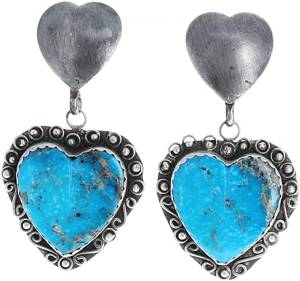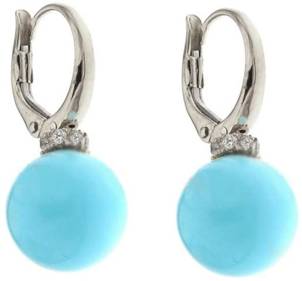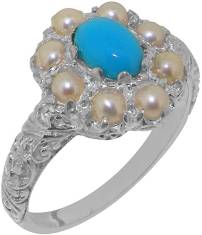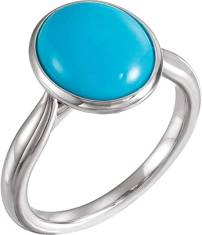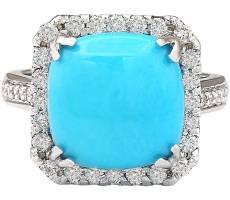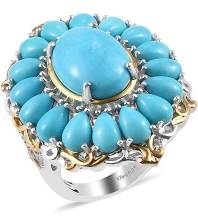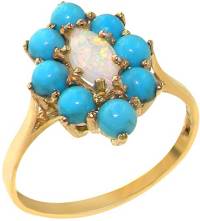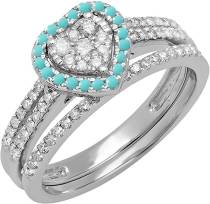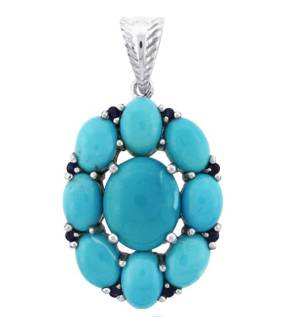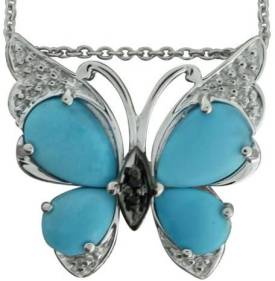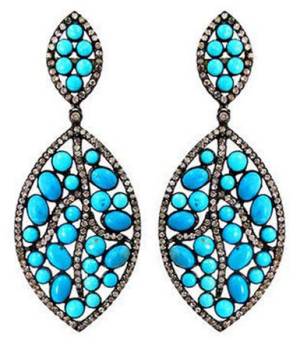Turquoise is the beautiful birthstone of December. It is an opaque mineral with a waxy luster. Connoisseurs collect them as ornamental stones. Fashion-forward individuals love to wear it as a jewelry gem. The dreamy blue allure of this jewel is captivating jewelry designers of today resulting in an enthusiastic resurgence of its popularity.
The gem is among the earliest protection amulets used by men. It was considered to be a sacred stone by the ancients protective against all manners of evil and ill health. It was also known as a symbol of affluence in many ancient cultures.
The Egyptian Pharaohs treasured this stone. The Aztec kings adulated this stone. The Native American Navajo people hold the stone very sacred.
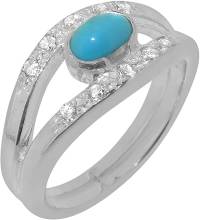
18k White Gold Natural Turquoise Diamond Womens Band Ring |
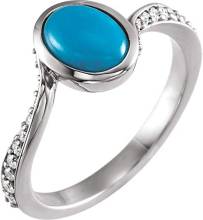
Turquoise and Diamond Ring in 14K Gold |
In European folklore, the gift of a turquoise ring says, “forget me not.” It is the national gem of Tibet, where it is considered to grant good fortune, good health & protection from evil. This December’s birthstone is also believed to impart peace to those who wear it.
The gem, when gifted by a loving friend is believed to shield the wearer from negative energy and bring good fortune. It is a symbol of friendship and brings peace to your home.
Where does turquoise form?
Arid regions of our planet play excellent hosts to the formation of this gemstone. Such barren & dry regions facilitate downward seepage of copper-rich acidic water. Upon reaching the depths, the chemical-rich water reacts with minerals containing aluminum & phosphorus. The chemical reaction produces hydrated copper-aluminum phosphate. This opaque to semi-translucent porous compound has been named turquoise.
We have discovered substantial deposits of the gem in Iran (formerly Persia). The American Southwest, the Sinai Peninsula in Egypt, and northwest China have also yielded appreciable quantities. History records show the first large-scale mines to exist on the Sinai Peninsula around 3,200 BC. The Maghara Wadi mines which are the oldest known-about source of this flamboyant mineral were also situated in this region. They supplied turquoise to the pharaohs for around two thousand years.
Mines were already being excavated in Persia [now Iran] in 2,100 BC. They gave us the revered “Persian turquoise”, celebrated for their bright, robin’s egg blue color. Persian turquoise was the finest material in the world.
Click On The Images
Turquoise mines near Nishapur in Iran are the stuff of legends. They have been spawning this gem for centuries. And they continue to do so even today. However, a number of these ancient mines have now been depleted.
Nowadays, China accounts for almost seventy-five percent of the global turquoise produce. Having said that, stones from China are routinely enhanced for color. As such, they are not regarded to be of good quality.
The American Southwest once harbored a booming community of turquoise miners. But most of the mines in this region are now closed. Regardless, some copper mines here yield gem-quality turquoise as a prized by-product.
What contributes the unrivaled color to turquoise?
All of us are well acquainted with its celebrated sky blue color. The gem, however, is found in a good range of hues. It can display pale powder blue and medium blue to beautiful bright green and yellow-green. The metals existing in the host rock bestow color to turquoise. Trace copper contaminants will give their signature blue. Iron tints it green whereas zinc besmears it with a yellowish tone.
The gem’s hue is extraordinarily remarkable and recognizable. As such its name has been conferred upon the color that lies somewhere between blue and green.
Why is turquoise classified as a semi-precious gem?
During the 1800s, gemstones were divided into two categories: precious and semi-precious. The classification was based on their valuation as per demand and supply of a stone at that time.
Accordingly, the so-called “big four” gems viz. Diamonds, rubies, emeralds, and sapphires were categorized as precious stones while all the remaining were bracketed as semi-precious.
The branding is not accurate today. The quality, rarity, and provenance attributes can render a purportedly semi-precious gem to be much more expensive than a precious one.
Even though fine turquoise is growing scarcer by the day making it all the more valuable, it continues to be dubbed as semi-precious. However much lovers of turquoise might like it to be grouped into the precious league, it is not likely to happen.
Click On The Images
Why is turquoise the gem so alluring?
The awesome robin’s egg blue synonymous with turquoise is seldom seen in minerals. Its captivating color is the main reason why gem enthusiasts fall in love with this jewel.
Moreover, this is among the oldest stones known to mankind. Also, influential people have regarded it as a powerful talismanic gem since time immemorial.
Further, the most prolific mines producing quality material have already closed down. Others are on the verge of closure due to depletion. Consequently, you rarely come across fine turquoise gems. The rarity is pushing up the price. Passionate collectors willingly pay prices higher than those of high-grade diamonds for the best specimens of turquoise.
People all over the world hold this gem in high esteem. The eminence gained by this opaque gem amply demonstrates an important fact. It is that the benchmark of beauty in a gemstone need not be bound to its clarity and transparency.
The name of this gemstone has been derived from the word ‘Turquie’ which is French for Turkey. The etymology refers to the traders from Turkey who first exported Persian turquoise into Europe. The early gemstones originated either from Alimersai Mountain in Persia (now Iran) or the Sinai Peninsula in Egypt. These are the two of the earliest known mining areas.
The name could also have stemmed from the French description of the gemstone, ‘Pierre turquin’ meaning dark blue stone.
6.7 Carat Natural Blue Turquoise and Diamond (F-G Color, VS1-VS2 Clarity) 14K White Gold Cocktail Ring for Women
Click On The Image
Deep blue lustrous gemstones (described as robin’s-egg blue) without flaws enjoy the best rankings. Such superior stones were put on by Pharaohs and Aztec Kings and can be better appreciated in antique gemstone necklaces.
The porosity, texture, and evenness of color are other key factors that fix the value of a turquoise gemstone. Evenness of color is sometimes even more important than the color itself.
But, the area of origin is the most important factor that determines the value of a turquoise gem. Also, the best specimens display an even, intense, medium blue shade.
Earlier, gems with the finest blue color were only mined in Persia (now Iran) and such a color is still described as ‘Persian Blue’.
However, today the term “Persian Blue Turquoise” is rather a description of quality than a declaration of origin. Presently, most of the world’s finest quality turquoises come from the United States, the largest producer of turquoise.
The gemstone is composed of copper aluminum phosphate. Its blue color is contributed by copper while its green is either induced by iron or is a result of dehydration. The gemstone often exhibits blemishes or veins in light black, grey, yellow, or brown colors depending on the type of rock in which it was formed. These patterns are referred to as the ‘Turquoise Matrix’.
Gemstones in lighter shades of blue depreciate in value. Also, the more the stone color moves towards green and the more blotchy and irregular matrix the stone displays, the lesser will be the value it commands.
Certain rare Turquoises display a particular pattern of the matrix that appears much like a spider’s web. It is called the ‘spider webbing’ or the ‘spiderweb matrix’. It has a complementary effect on the stone’s look, enhances its beauty, and adds substantially to its value.
Click On The Images
The hardness of gemstone used for jewelry varies from 5 to 6 on the Mohs scale. The hardest variety is frequently found near the surface of the earth, where it gets a chance to dry/cure. More commonly, turquoise is chalk-like; too soft, and porous to be used unless it’s treated.
The term ‘natural turquoise’ is used to describe two different types of gemstones.
Firstly, it is used to describe a gemstone that has not been treated in any way either with coloring pigment and stabilizing epoxies or with other chemical treatments aimed at altering the color, hardness, or luster of the stone. It is said that only around 3 to 10% of mined turquoise is of adequate hardness to be used in jewelry without stabilization.
In addition, the term ‘natural-turquoise’ is also used to describe a gemstone that has not been treated with coloring pigment or epoxies but has been given a wax or oil coat for protection. Such a coat is given to prevent discoloration, staining, and dehydration which are possible on account of the porous nature of this gemstone.
Whatever might be the treatment given, turquoise-gemstone jewelry needs protection from cosmetics, heat, and bright light.
Owing to its porosity and low hardness, this gemstone is rarely ever faceted. It is generally cut in cabochons or beads for use in gemstone jewelry. Turquoise beads are often seen in necklaces and bracelets.
Turquoise jewelry, widely admired for its bright blue hue, symbolizes protection and hope through the centuries. With its wide usage in antique jewelry and its incorporation into innovative modern pieces, this gem is a great addition to any collection. The gem is also incredibly affordable. This means that everyone can have a piece of this December birthstone.
For many thousands of years, the stone has been looked upon as holy and a bringer of good fortune. It has been worn in form of gemstone rings, as natural protection against darkness since times immemorial. It is believed to bring faithfulness and constancy to relationships.
In Iranian architecture, the blue turquoise was used to cover the domes of the Iranian palaces because its intense blue color was thought to be a symbol of heaven on earth.
Persians believed that seeing the reflection of a new moon-on-turquoise brought luck, and safeguarded against evil. They also believed that looking at the stone could sharpen eyesight and placing it on an inflamed eye was considered to be a cure.
In modern gemstone therapy, those suffering from depression are suggested to wear this gemstone. Its cheerful color brings happiness and inspires confidence.
Zayn Malik hugs Gigi Hadid, with a silver and turquoise gemstone ring on his right-hand index finger in the August-2017 issue of Vogue. Johnny Depp rolls up his sleeve to reveal an armful of jewelry, including a turquoise-and-silver bracelet in an advertisement for Sauvage, the men’s fragrance from Dior. Also, Tom Ford wears a cuff and an outsized turquoise belt buckle in a recent spread in GQ. Fashionable men are completely smitten with this blue-green gemstone.
14K Gold Round Turquoise & White Diamond Ladies Heart Shaped Bridal Engagement Ring Set
Click On The Image
Designer Phillip Lim is collecting turquoises jewelry since his teen years. He considers the stone a talisman of protection. It is a tribute to the fabled metaphysical and spiritual attributes of the gem.
The turquoise-silver combination has a long-established history. The patina of aged silver harmonizes well with turquoise. The blend is synonymous with Native American jewelry cultures of the Navajos and myths of the Western frontier.
People are enamored with a heroic and manly aura of the American wild-west. The artifact like turquoise-silver jewelry is at once mystical and masculine. It appears to be anointed with marks of age and heritage. The look is organic and very masculine.
Trend experts opine that the gemstone turquoise is a rising star in the jewelry world. It consistently remains among the most searched terms on jewelry websites.
Turquoise Buying and the Four Cs
Like most gems, the four attributes known as the four Cs are considered to ascertain the value of a turquoise specimen. They are as follows:
Color:
Blue hues are characteristic of this copper mineral. Nevertheless, it can also take on blue-green, green, or even yellowish-green shades. A vivid blue with little green is by far the most valuable color.
Even though their value is less, green hues caused by chromium or vanadium impurities also have their fan following. Iron-tinted turquoise has yellow hues. Lime green turquoises are not as valuable. Yet, they are sought after by certain artists for particular artworks.
The presence of strontium makes the stone display a unique secondary purple hue.
Optimum stone color is even and saturated with no noticeable color zones. Nevertheless, connoisseurs covet a particularly rare color zoning that generates a “bird’s eye” effect featuring light nodules surrounded by dark material. Arizona’s Turquoise Mountain mine yielded this material once upon a time.
Furthermore, turquoise with a medium-dark tone commands the highest value. Stones with excessively dark tones appear lifeless and bland. On the other hand, medium tone accentuates the well-loved vivid hues.
Sleeping Beauty Turq Natural Gemstone Oval Shape Pendant in White Gold
Click On The Image
Clarity:
Turquoise is typically an opaque mineral that forms a matrix. Though it is rare, you can sometimes find translucent specimens too. Likewise, crystalline turquoise is incredibly difficult to find. You will only find them in Lynch Station, Virginia, region.
Even so, the matrix occasionally forms an eye-catching spider-web pattern. Exotic matrices appeal to connoisseurs, and they willingly pay a premium for them. Stark juxtaposition with the bright blue color of turquoise makes black and dark brown matrices immensely desirable. Furthermore, golden and red matrices look simply stunning. Conversely, an ugly matrix devalues the stone significantly.
Hardness:
Hardness can vary based on the matrix present in the stones. For example, stones rich in clay minerals are softer and more porous. A profusion of silicate minerals, on the other hand, makes the turquoise less permeable and relatively harder. As such, turquoise stones show an astonishing range of hardness. On the Mohs scale, they can be as soft as 3 and as hard as 7.5.
Hardness imparts durability to the stones. Also, metalsmiths find it easier to set such jewels into jewelry. On the other hand, softer stones require treatment to add stability. Harder specimens, therefore, command a higher price.
Cut and Form:
The best stones are usually cut into cabochons. Lapidaries carrying out inlay or carving works make use of such premium material. Meanwhile, the material of choice for beads is generally of low quality.
At times, the earth’s geology shapes out natural fossilized pseudomorphs of turquoise. Luckily, the bright hues and appealing shapes make these pieces exceedingly rare.
Other rare geochemical forms of this mineral are the Turquoise geodes. Environmental processes skillfully form such gorgeous geodes over thousands or even millions of years. As a result, they make an excellent addition to any mineral collection.
Turquoise Natural Gemstone Pear Shape Pendant White Gold Wedding Jewelry
Click On The Image
Carat:
Turquoise readily occurs in large sizes. And yet, the occurrence of large pieces without visible matrices is rare. For larger sizes, prices do not escalate steeply. Even so, rarity will add substantial value to a large stone that is matrix-free.
Region of Origin:
Connoisseurs revere deposits of certain mines for being of the finest quality. Turquoise from such sources is more desirable and hence more valuable.
Turquoise From China:
Chinese mines supply virtually all commercially accessible turquoise in the United States. Most of this material is low-grade and stabilized. Yet, the material provided by the Yungai and Zhuxi mines is usually high-grade.
Iran (Persian Turquoise):
Material mined from Iran, particularly the Nishapur mines, displays the highly coveted turquoise color. It is an even, intense, medium blue. Gem buffs call it robin’s egg blue. Such gems from Persia set the yardstick for the finest turquoise gems. However, you seldom see these stones in the market today as the mines have exhausted their supply.
Tibet:
Turquoise is the national gem of Tibet. Tibetan gem is a treasure mined in the Himalayas. Four locations in Tibet are famed for yielding the finest stones. They are Lhasa, Ngari-Khorsum, Draya, and Derge.
Antique Tibetan material seen in the market has turned green with age. The greening happens because the stone absorbs fluids from the skin. Therefore, fine blue antique material is uncommon but available.
Egypt:
Discoveries made in ancient Egyptian tombs tell us about the earliest use of turquoise gemstones. The burial chambers held elaborate turquoise jewelry dating back to 3000 BCE. The Egyptians designed scarabs out of turquoise and mounted them in gold necklaces and rings. A prominent example of this was King Tutankhamun’s burial mask. Egyptians of the time lavishly ornamented this mask with turquoise.
Egypt’s Sinai Peninsula is host to the oldest turquoise mines. Green to greenish-blue stones occur in brecciated deposits with significant limonite. These deposits once produced turquoise for the pharaohs. Unfortunately, the color of some materials can fade in the sun.
Australia:
Australian turquoise is a stunning gemstone. It exhibits an attractive range of blues, including bright-pastel blue, bright-medium sky blue, and rich robin’s egg blue. In beautifully rippled ‘spider web’ like vein patterns, coffee, and chocolate matrix accentuate the gems brilliantly.
You can find turquoise nodules of high quality in Australia. These stones rival the Iranian ones in quality. But, unfortunately, the material is somewhat fragile.
14k Gold 27CT Turquoise Gemstone Diamond Pave Dangle Earrings Jewelry 925 Silver
Click On The Image
United States:
Nature has blessed the Southwest United States with many mines. Each produces a distinct variety of turquoise. As such, experts can sometimes pinpoint the origin-mine just by looking at a sample. Fine stones from famed mines fetch high prices. Listed below are some of the famous mines.
The Nevada “Fox Mine,” Also Known As “Cortez Mine”:
Fox Mine is a significant source of American turquoise. Stones from this mine display colors ranging from rich forest greens to soft blue. It is also well known for its teal and green stones. In addition, the hard matrix carried by the gems makes them good quality material.
Sleeping Beauty Mine, Arizona Region Nevada:
The Arizona region is host to the Sleeping Beauty mine. Enthusiasts covet the material from this mine for its pure sky blue color and absence of matrix. Consistency of color has made it a favorite among the Zuni for their inlay jewelry. The Navaho prefer it for their cluster work for the same reason. Unfortunately, the mine has been depleted and closed. Turquoise from this mine has dramatically appreciated for this reason.
Royston District, Nevada:
Turquoise from Royston ranges in color from a deep sky blue to dark green. The colors frequently blend in the same stone. Brown mottled or webbed matrix further enhance the stone’s look. Alas, production from this mine has dwindled to the barest minimum.
Bisbee Mine, Arizona:
Bisbee materials have acquired an excellent reputation for their hardness, brilliant blue color, and superior quality. Minerals from this area show up in quite a few different shades of blue with reddish-brown spider-webbing. As the webs run through the stone, they look like wispy veils. People in the trade refer to them as the “Smoky” matrix pattern. Turquoise gemstones found in Bisbee, Arizona, are the only ones that display such a “Smoky” pattern.
Unfortunately, the Bisbee Mine has depleted and is no longer operating. Therefore, material from this location is scarce.
Kingman Area, Arizona:
Once an essential source of turquoise, Kingman now rarely produces high-quality gems. Material from this mine is light to medium blue with a white matrix. However, the white matrix is often dyed black to contrast with the natural blue colors. In addition, quartz and pyrite crystals are sometimes present, adding a sparkle to the stone.
Carico Lake Mine, Nevada:
The Carico Lake mine in Nevada supplies this distinctive material. The mine gets its name from a dried-up lake bed. Turquoise produced at the mine ranges from dark blue to light green. Some of the stones feature yellow or dark blue “water” webbing.
Its intense apple-green variety is most in demand. A dark spider-web matrix tints the green of the gem.
Although this locality produces plenty of material, fine gems in this region are rare.
Lander Blue Mine, Nevada:
The region between Battle Mountain and Tenabo in Lander County, Nevada, nestles this mine. The vibrant Lander Blue material found here is composed of bright blue turquoise and dark spider webbing.
Aficionados consider this gorgeous gem to be the most valuable turquoise known. Yet, miners have dug out less than 110 pounds of this beautiful spider-web turquoise ever. So whatever is still around is rare and valuable. Consequently, the buyers should be careful. Furthermore, they should be alert that material marketed as Lander Blue may not be authentic.
Number Eight Mine, Nevada:
In Eureka County, North of Carlin, Nevada, the Lynn mining district encompasses the Number 8 Turquoise mine. The quarry is closed to turquoise mining, and current owners now dig out gold from here.
The Number Eight Mine once provided stunning specimens with exquisite red and black spider webbing. This region’s rare and highly prized gem is known for its brilliant contrast and occasional large nuggets.
Treatments:
Gemstone vendors routinely use treatments to enhance the color or shine of lower grades of turquoise. Make sure you ask about such treatments before purchasing fine turquoise.
Stabilization:
When infused with epoxy resin, wax, or acrylic polymer, softer and more porous materials achieve a relatively higher hardness. You can simultaneously alter the stone’s color if you introduce dyes while executing this process. Cutting and polishing are made more accessible by stabilizing a stone. Stabilized material is also known as “chalk turquoise.”
Dye:
Dyeing processes help to darken light-toned specimens. But, what’s more, the technique also darkens the light-colored matrix. Shady elements sometimes dye other minerals to look and sell like turquoise.
Oil and Wax:
The cryptocrystalline structure of Turquoise material makes the gem porous. Body oils, grime, and household solvents can permeate this semiprecious stone because of this porosity. Consequently, the stone becomes prone to discoloration and darkening.
Even high-grade turquoise is often coated with wax to protect the porous stone. In addition, oil or wax coatings enhance the material’s luster and darken it to a certain extent.
Zachery Treatment:
Lapidaries bathe turquoise in a proprietary solution while carrying out this treatment. The above soaking makes the material less porous and more lustrous. We don’t use Polymers or dyes in this method.
Synthetics and Simulants:
Turquoise’s popularity breeds many imitations and phonies. Unfortunately, unscrupulous elements in the trade try to pass them off as genuine turquoise. Dyed howlite and magnesite are a couple of such fabrications.
| See Also: | Mens Turquoise Bracelets |
See More Gemstones As Follows
